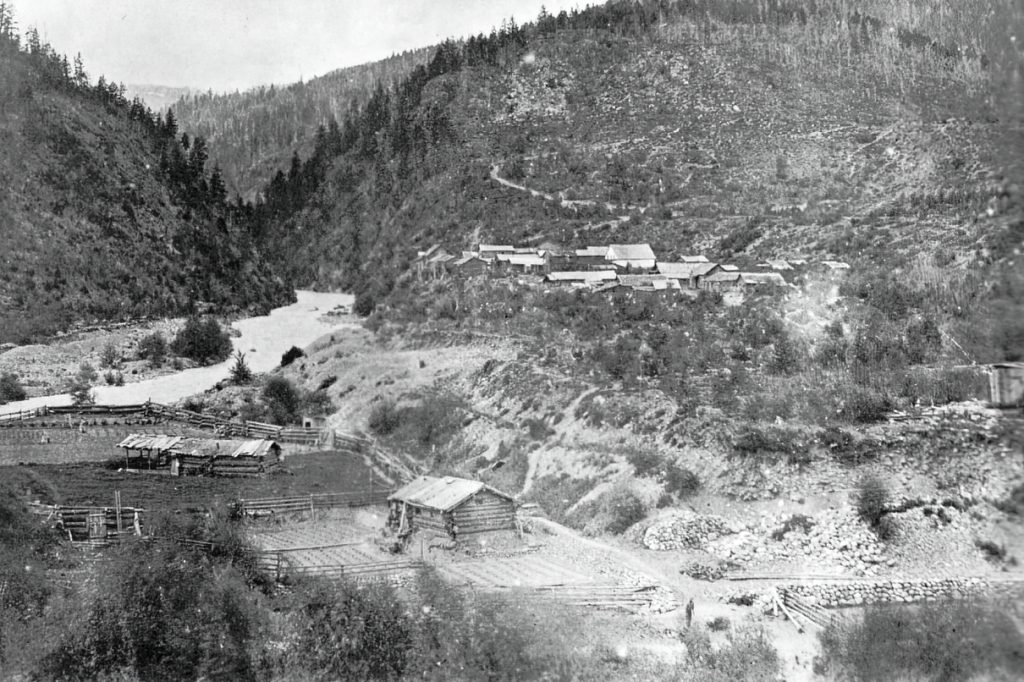The life and death of a very special gold rush

Granite City, British Columbia, 1888. George Dawson photo. Source: British Columbia Historical Federation.
By Ellsworth Dickson
In the early days, Canada’s most western province, British Columbia, was built on gold. While there were the famous gold rushes of the Fraser River in 1858 and Barkerville in 1862, there is one gold rush that stands apart from the rest – the Granite Creek gold rush near Princeton, southwest B.C.
What make Granite Creek different is that besides gold, there are also platinum nuggets – one of only two places in the world – the other being the Amur River in Russia.
It all started in July 1885 when a sometime cowboy/sometime outlaw named Johnny Chance (no kidding) showed up in the Tulameen Valley northwest of Princeton where there was some modest placer mining operations..
He signed on for work at a placer mine; however, as it turned out, fortunately, he had a serious personality flaw – he was chronically lazy. Placer mining was hard work. So got a job as kitchen helper but peeling potatoes and washing dishes was actual work too, so the cook handed him a rifle and told him to go shoot something for dinner.
You guessed it: he was too lazy to hunt. He found a nice creek (Granite Creek) that flowed into the Tulameen River and lay down for nap with his feet in the cool water. When he awoke and sat up, he looked down at his feet and saw something gold-colored and shiny. Picking it, it was obviously a gold nugget. Then he found more.
Filling his buckskin purse with nuggets, Johnny ran back to camp hollering “GOLD! GOLD?”
His discovery spread like wildfire and soon hundreds of miners – both European and Chinese -flooded in. The town of Granite City – sometimes called Granite Creek – was born. It didn’t take long before there were 2,000 people, 13 saloons, 14 hotels and restaurants, two blacksmiths, two jewellers – but no churches or schools. This was the fifth biggest town in British Columbia with some 200 buildings. There was even a jail – with no bars! All the windows were one foot square so no one could escape – and they didn’t.
At first, most of the European miners were stymied by the small silvery-grey nuggets they recovered with the gold. Not knowing what they were, they threw them away. However, the Chinese realized that the odd nuggets were some kind of metal and wisely kept them for great profits (at US$0.50/oz) later when a geologist correctly identified them.
The gold values occurred at surface and at shallow depths; however, most gold was at bedrock. Some miners had to dig 25 feet to reach the gold channel. For the first year of discovery (1895), gold production reached an estimated $100,000 (at US$20/oz). For 1896, it totalled $203,000. For 1897, gold production was $128,000 with about 2,000 ounces of platinum recovered.
That was the best year and like all other gold rushes, placer gold is a finite resource and production declined. By the year 1900, Granite City was dead. According to the late B.C. mining historian, Bill Barlee, the value of Granite City’s gold production is estimated to be about $450,000. If you add the earlier years for the entire camp, to total is probably some $1 million plus an estimated 15,000 ounces of platinum.
By 1915, after several fires, Granite City was a ghost town. During the 1930s, some enterprising miners reworked the area including burning down some old prospectors’ shacks to recover the platinum nuggets in the ashes that they had discarded.
Today, the Tulameen Valley and all the pertinent placer creeks have been staked with mineral or placer claims. However, there is another treasure in the Granite Creek goldfields just waiting for discovery.
During the gold rush, a Swedish prospector named Johanssen recovered about 20 pounds of platinum nuggets and saved them in a bucket. When he abandoned his diggings he buried the bucket near his cabin. He never returned and the bucket of platinum has never been found. This story has been reported by a number of publications over the years.
There is hardly anything left of Granite City but it’s only a 3 ½-hour drive east of Vancouver and an interesting place to visit. The town of Princeton is a going concern with the nearby Copper Mountain copper mine providing over 400 jobs as well as some active exploration projects in the neighbouring hills.
